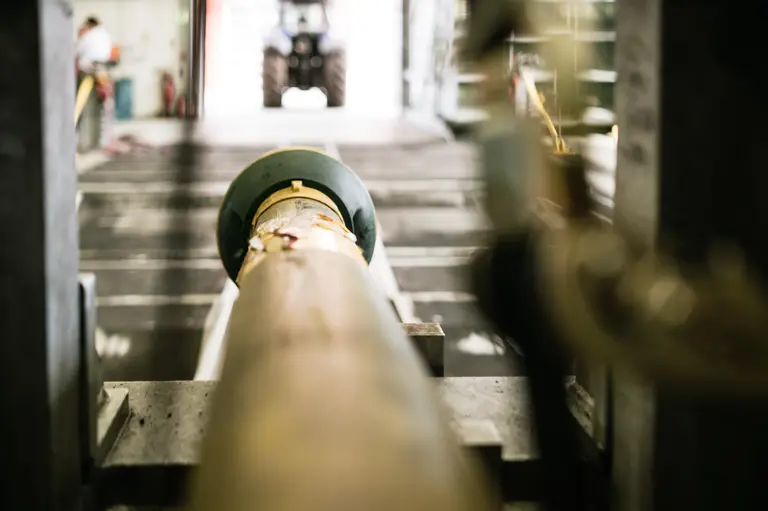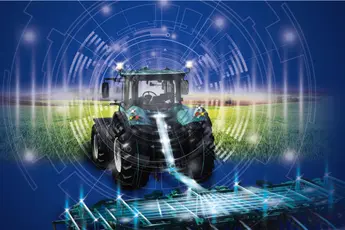Field emergence, longitudinal plant distribution and lateral fertiliser distribution - in DLG tests of precision air seeding equipment, the quality of work is closely scrutinised. In the DLG test, the 6-row maize seeder Precea 4500-2CC Super from Amazone, equipped with PreTeC sowing units, was examined.
As early as the 19th century, fixing individual seeds the same distance apart on belts of paper or cotton, which were unwound from large drums in the field, enabled almost perfect precision seeding. The first attempt to build a mechanical precision air seeder is also a year older than the DLG.
Historical development
Magens and Wagner applied a technical solution to bean cultivation as early as 1884. In their bean drill they used scoop wheels whose double row of oval cells were adapted to the size and shape of the seeds. These were mounted at the distance of the seed rows on a common shaft, which was driven by a ground wheel. Since the cell wheels could only be used for certain seeds and the filling of the cells also had a high error rate, Jules François Mathias proposed the use of a pneumatic principle as early as 1897. This is largely independent of seed size and seed shape and significantly reduces the risk of mechanical damage to the grains. Thus, the foundations of today's precision seeding technology were already laid 120 years ago.
And to stay in crop production: Amazone now shows once again the fruits of this historic development.
Amazone technology in the test
With the 6-row precision air seeder Amazone Precea 4500-2CC Super, equipped with Amazone PreTeC sowing units, a current product met the high demands of a DLG test. The sowing units fitted to the test machine were equipped with electrically driven singling units, a 55 l seed hopper and a 17 l hopper for micro granular. The complete sowing unit is guided in depth by two support rollers, while the seed placement depth, the pressure of the pressure rollers and the contact pressure of the entire sowing unit in the tested version can be manually adjusted by the operator without tools by means of a lever adjustment. More comfort is offered by the optional expansion stages of the hydraulic coulter pressure system or even the automatic, pressure sensor-supported coulter pressure control.
The Precis mineral fertiliser system for underfoot fertilisation is installed in front of the actual sowing unit. With this system, the application quantity is metered with a separate metering unit for each row. In the standard version of the test machine, all six metering units are driven by a central electric motor and the fertiliser supply from the tank to the metering units is controlled via manual sliders. For GPS-controlled individual row shut-off, however, each row can optionally be equipped with a separate electric motor. The sowing unit itself is also equipped with a double disc coulter with furrow former. This ensures precise seed placement and thus uniform field emergence by reconsolidating and levelling the furrow created. The grains from the sowing unit are caught by a catcher roller and thus pressed into the preformed seed furrow for optimum soil contact. The catcher roller is then followed by two press rollers.
The actual grain singling works with compressed air, which presses the grains into the holes of the electrically driven singling disc. When leaving the singling disc, the seeds pass an optical sensor, the data from which can be used to optimise the scraper position for each row individually so that the proportion of double and defective spots is minimised.
Test results
In the laboratory, the placement accuracy and grain spacing were determined for three maize varieties at 6, 9 and 12 km/h and a target spacing of 14 cm. At the same time, the fertiliser lateral distribution was measured. Here, the test machine consistently achieved top marks for the double and missing parts, and the same applies to the fertiliser lateral distribution. For the standard deviations of the grain spacing, there were satisfactory to good ratings on the test stand. Regarding the results of the field test: The field emergence was exclusively rated "very good" across all trial variants. They were between 94.5 and 98.0 %. The standing accuracy of all sowing variants applied was rated as "very good" or "good" depending on the maize variety and driving speed.
Conclusion
The 6 row Amazone Precea 4500-2CC Super maize drill with Precis mineral fertiliser system for under foot fertilisation and Amazone PreTeC sowing units could convince during the test with regard to the test criteria set in the DLG test framework. Based on the results achieved, the seed drill was awarded the test mark "DLG-ANERKANNT" for the test module "Working quality including fertiliser lateral distribution" and the sowing unit for the test module "Working quality in maize" for working speeds of up to 12 km/h. The test reports with further detailed results and assessments are available free of charge at www.DLG-Test.com.

















































